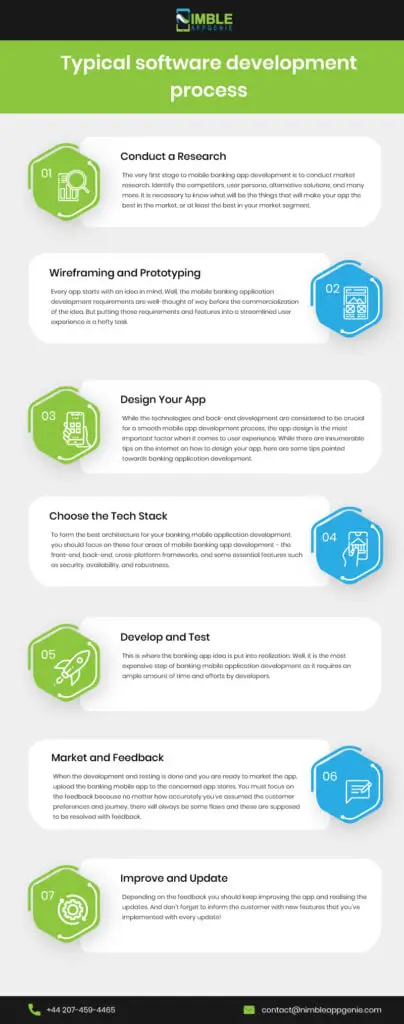7 Ways to Improve Mobile App Development

When developing a mobile app, it’s important to focus on the core feature. Focusing on the wrong parts of the process can result in lost time and quality. Moreover, focusing on the wrong things could lead you to miss the idea behind your app. To avoid this, consider the purpose of your app, and distill it down to a single sentence.
Implementing clear KPIs to measure the success of your app
Implementing clear KPIs to measure the performance of mobile app development is an important step in developing an app strategy. These metrics help you to optimize your app and attract stakeholders such as investors and shareholders. The key is to select the right metrics. The right KPI will be different for each category of mobile app. In addition, the KPIs must have defined objectives and desired outcomes.
Besides user engagement and conversion rates, another important metric is user retention rate. This measures how many users use an app after they install it. A high retention rate indicates success. An app can generate a lot of downloads, but it won’t do much good if most of these users uninstall it after a short period of time. Keeping an eye on user retention will help you determine if your app is successful or not.
Besides customer engagement and conversion, you should also measure customer satisfaction. This metric will let you know which features of your app are interacting with users. By knowing how satisfied your customers are with your app, you can improve its features and customer retention. Happy customers will be more likely to use your app again.
In addition to these metrics, you should monitor the average length of each app session. The length of a session indicates how engaged your users are with your app. The longer the sessions, the higher the user engagement. For example, a gaming app will have a greater average session depth than a non-gaming app.
Retention is one of the most important metrics when it comes to mobile apps. Expert interviews on the topic all mention retention as a must-measure. There are several methods to measure retention, including N-day retention, bracket retention, and rolling retention. Selecting the best metric will depend on the type of app you’re developing.
Using mobile application management (MAM) to test your app
Using MAM to test your app is one way to ensure that it’s safe and secure for employees to use. The software is built to make it difficult for an employee to download an unauthorized app or enroll their device in an app store that shares data with other employees. It can also help you protect sensitive company data by ensuring that only certain apps are available within the MAM system.
One MAM feature is application sandboxing, which isolates apps from each other on mobile devices. This is very important for companies with staff who use their mobile devices for both personal and work purposes. It lets staff use their phones for personal purposes while maintaining a high level of security for work-related apps.
MAM is an excellent tool for IT administrators looking to protect sensitive business data. It offers a unified approach to data security and can be deployed to iOS and Android devices. It allows administrators to make minute changes to apps to reinforce authorization levels and improve security. This is especially useful for companies with many remote employees who use their mobile devices for work purposes.
If you’re developing a mobile app, using MAM is one of the best ways to ensure that it’s secure and safe for users. It can help prevent cyber attacks and data loss, while also improving productivity. MAM also lets you manage your app’s lifecycle, ensuring it’s always updated and protected.
Mobile application management (MAM) is an effective and proactive way to test your app, as it allows you to prevent problems from escalating and ensure your customers’ data is protected. With MAM, IT administrators can apply and enforce policies for your mobile apps and make sure they follow security guidelines.
Creating a simple yet intuitive UX
Developing an intuitive user experience is an essential component of mobile app development. A user-friendly interface not only makes the process easier, but also encourages users to spend more time on the app. It is therefore crucial to follow a standardized design approach to maximize the benefits of a mobile app.
The first step in developing a user-friendly app is creating wireframes of the different aspects of the app. A wireframe enables you to see how users will interact with different features within the app, and makes it easy to make changes to the app before design begins. The wireframe will also let you perform click-through analysis to ensure that users can navigate through the app with the least amount of friction.
The user interface (UI) of a mobile app is everything that the user can see and interact with. A simple yet appealing UI design can help set your app apart from other mobile apps. Creating an engaging and visually appealing UI requires a lot of planning and research. You should also be aware of the requirements of your app and its target market to ensure that it is suited for their needs.
While it is important to keep the mobile app’s design consistent from device to device, the UX will also vary. Different devices have different screen sizes, OS, and manufacturers. It’s essential to hire a design team that provides strategic consulting to ensure that the app’s UX meets all of its goals. This isn’t possible if you’re hiring an Upwork or Fiverr designer, who will simply do the job and move on to the next project.
Another important aspect of mobile app development is the flow. The flow is the connection between screens and functions. It is also known as navigation. Having a mobile app that is difficult to navigate isn’t a good sign, and users will abandon it after a few tries.
Testing in parallel to the development stage
The use of parallel testing helps in reducing the time and effort of testing an app. It allows developers to run more tests in less time and generate more data. Moreover, this process increases the quality of the end product. It also allows developers to test new and early developments.
Mobile operating systems are constantly evolving, which makes it necessary to test your app for compatibility across different versions. For example, iOS and Android are constantly releasing new updates to their operating systems. This means that you need to test your app on each update to make sure it works properly and doesn’t cause problems.
Parallel testing allows you to perform tests in a variety of browsers and environments. The process also enables you to identify differences between a new and legacy system. You can use test automation tools or manual means to perform parallel testing. In this way, you can speed up your development process and increase your revenue.
Moreover, parallel testing reduces cost per test because you don’t need to build an in-house device and browser infrastructure. You can use cloud-based testing grids to do multiple tests in a single run. This way, you can minimize blocked tests by having a higher number of tests running at once.
Parallel testing works best with continuous integration (CI). This allows teams to run tests as soon as developers submit code changes. This allows for faster feedback and quicker communication among teams. It also increases the speed of testing, meaning you can run more tests in less time.
Signing an NDA agreement
If you are the owner of an app idea, you may be wondering whether signing an NDA agreement would be helpful. While signing an NDA can protect you, it may also cost you money. It can be difficult to prove that you invented an idea, and signing an NDA can increase legal costs. Plus, it is a poor substitute for trust. As a business owner, you should always build trust with your developer before sharing any sensitive information.
It is best to consult an expert on the NDA if you have any questions. A sample NDA can be found online, but it does not contain everything you need. The document should be tailored to your company’s needs. If it is too short or too long, it will not protect you from the risks associated with sharing your business secrets.
When it comes to developing a new app, it is important to obtain user feedback before launching it. Without a user base, you may never know how much people would actually use it. That is why you should sign an NDA agreement as soon as possible. This protects your idea from being stolen. Furthermore, signing an NDA agreement will prevent you from making any public announcements about your app.
There are three types of NDA agreements, and it is important to choose the right one for your needs. A mutual NDA is ideal for mobile app development because it requires only two parties to sign it. However, if you’re working with multiple partners, you should consider a multilateral NDA. This type of agreement is ideal for mobile app development because it allows two or more parties to share information without fear of a conflict.




